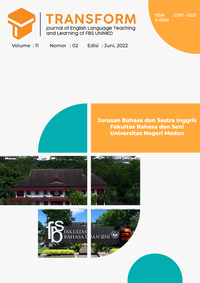An Analysis of Verbal Irony in Emma Donoghue™s Room
DOI:
https://doi.org/10.24114/tj.v11i2.43993Keywords:
Room’s novel, Irony, Verbal Irony, Figurative LanguageAbstract
The objectives of this study were to find out 1) To found out what types of verbal irony used in the novel, 2) To found out the literal meaning of the verbal irony, 3) To found out the realization of the verbal irony. The source of data was the novel, and the data were taken from the dialogue in the novel. The study conducted by using qualitative research. The data were analyzed by using Sperber and Wilson™s theory to classify the types of verbal irony. There were 13 data found and there were two types of verbal irony used in the novel spoken by the two main characters. The types were ironical understatement (92%) and ironical interjection (8%). The literal meaning and the realization of the verbal irony were known based on the context in the dialogue.Downloads
Published
2023-06-05
Issue
Section
Articles
License
Copyright (c) 2023 Melvi Dwi Arfina Harahap, Zainuddin Zainuddin

This work is licensed under a Creative Commons Attribution-ShareAlike 4.0 International License.
Authors who publish with this journal agree with the following terms:
- Authors retain copyright and grant the journal right of first publication with the work simultaneously licensed under a Creative Commons Attribution License that allows others to share the work with an acknowledgment of the work's authorship and initial publication in this journal.
- Authors are able to enter into separate, additional contractual arrangements for the non-exclusive distribution of the journal's published version of the work (e.g., post it to an institutional repository or publish it in a book), with an acknowledgment of its initial publication in this journal.
- Authors are permitted and encouraged to post their work online (e.g., in institutional repositories or on their website) prior to and during the submission process, as it can lead to productive exchanges, as well as earlier and greater citation of published work (See The Effect of Open Access).
- This work is licensed under a Creative Commons Attribution-ShareAlike 4.0 International License.

This work is licensed under a Creative Commons Attribution-NonCommercial-ShareAlike 4.0 International License.



